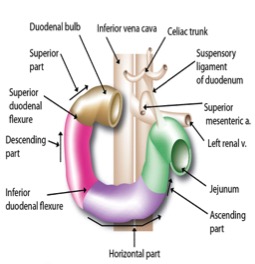The Duodenum
- kelsolson
- Feb 20, 2024
- 2 min read
The Duodenum
In the small intestine, the chemical digestion of food is completed, and most of the absorption of nutrients takes place. The duodenum is the first part of the small intestine, and is directly attached to the pylorus of the stomach. It is centrally located within the abdominal cavity, and because of this central location-it has direct contact with almost every abdominal organ. It is a c shaped organ about 25-30cm long, which curves around the head of the pancreas. The duodenum is the site where both the bile, and pancreatic juice enters the gastrointestinal tract. It neutralizes acidic gastric juice, aids in mechanical digestion, mixes bile and pancreatic enzymes, and absorbs water. The common bile duct carries the bile from the liver via the gallbladder and the pancreatic duct carries the pancreatic juice. The contents enter the duodenum at the sphincter of oddi, located in the second portion of the duodenum.
Visceral Manipulation, and the Duodenum:
Visceral Manipulation is a gentle, and supportive manual therapy. Working with the ligaments, and tissues surrounding the organs. If you’re curious about the therapy in general, click this link to read more:
When evaluating any of the viscera, we check for alterations in the proper physiologic placement of the organ. We tune into the mobility & motility of the organ, ensuring it has adequate space to utilize its full and proper axis of movement on its own, as well as in relation to other viscera. If we tune into these movements, and find that there are no discrepancies, that everything seems to be moving as it should be-we simply move on to another area.
When working with the viscera, we do so with the thinking of “less is more”. Working with each organ a maximum of 3 cycles of mobilization in each plane of movement, so as not to overwhelm it. The beautiful thing about our bodies, is that they are always working. The changes we support through these mobilizations will continue to take place over hours, days, and weeks going forward as your bodies continue to do the work.
Who can benefit from Visceral Manipulation of the Duodenum?
Those with R psoas muscle shortening. Anyone suffering with congestion in the R testicular or R ovarian vein. Problems with digestive circulation, Ureter issues, struggles with the reproductive system. Ulcers, trouble eliminating toxins, constipation, lower abdominal pain after periods of standing, breathing difficulty which improves upon laying down.
Those who have been in a motor vehicle, or inertia based trauma (whiplash, high velocity impacts etc). As our bodies have to brace our internal organs upon impact, and as a result, may have developed areas of restriction. Those who have undergone an abdominal or pelvic surgery, as this creates scar tissue, and a drying out of the tissues making them less pliable, and more prone to adhesion. Pregnancy, as our organs have to do a lot of rearranging in order to make space for a growing baby.
Sources: VM1-Barral Institute
Visceral Manipulation: Jean-Perre Barral & Pierre Mercier
Physiological and Clinical Applications of Visceral Manipulation: Ron Mariottikenhub.com









Comments